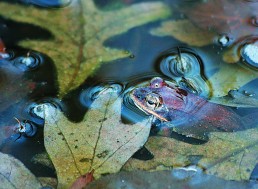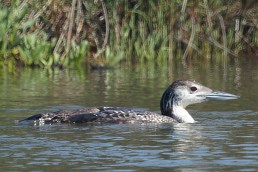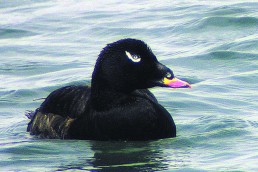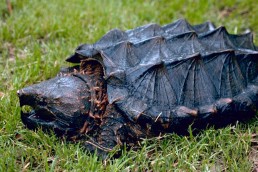Nature Notes
SHARE THIS POST
Knock on wood: Their future is looking brighter
The Midwest is not home to any “true” tortoises, but it has a species that looks the part. In all of its glory, the wood turtle is one of our most unique reptiles. They live only in the north and northeastern parts of the Midwest region, and are fairly rare inside their respected range. What has caused their numbers to decline, largely, is similar to most threatened creatures—habitat destruction. Heavy predation and road mortality have also contributed to their decline. In addition, wood turtles cannot reproduce until the age of 14, and do not reproduce often.
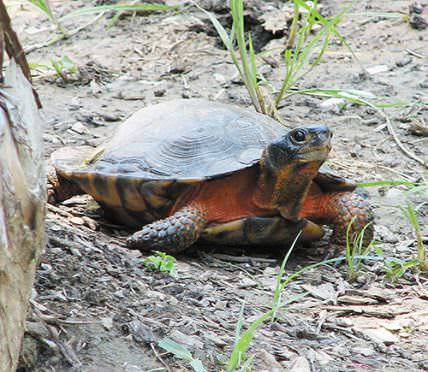
But on the upside, once they’ve reached adulthood, their survival rate is very high. As with many other turtles, wood turtles prefer moving water with sand banks for basking and nesting. One easy way to identify a wood turtle is their pyramid-like shell and the orange and yellow lower half of their body. An adult might measure less than 10 inches from tip to tail, but their small size is made up by how much they travel in a day, which averages around 350 feet, an impressive feat for such a small creature. Wood turtles are omnivorous—their diet includes plants, fungi, carrion and insects. With so many intriguing characteristics, it’s a shame they’re not found in higher numbers. Fortunately, conservation efforts are underway to secure the future of the wood turtle.
Craters on the surface of the sand
Shallow sunfish (bluegills, pumpkinseeds, redears, etc.) nests are a frequent phenomenon in the Midwest, but what it takes to build a nest might be a surprise. First, the male digs a 6- to 12-inch crater-like hole in sand or light gravel by aggressively fanning his tail. Males will build their nests in large clusters, typically using the same sites year after year. If any creature deemed a threat comes near the nest, the male becomes defensive and attacks, even taking runs at predators double his size. The males are even aggressive toward females that wander back onto the breeding grounds. During the breeding ritual, females usually only show interest in the larger males. When she decides to check out a male, he will make noises and swim in circles. If and when a female enters a nest, they both circle one another then will both settle in the middle of the nest. The male shifts to a vertical position, and the two touch and vibrate several times until the dance is done. Soon after the eggs are laid, the male chases the female away and fertilizes the eggs. It is then the male who watches over the eggs. Although it is easy to catch bluegills guarding their beds, the practice is generally not recommended, as removing the male leaves the eggs vulnerable to predators.
Downy’ to earth and ‘hairy’ easy to tell apart
The drilling sound made by woodpeckers is a normal part of a forest symphony. It might not be the most beautiful sound, but it’s a comforting sound that lets you know you’re experiencing nature. There are two common species of woodpeckers, and they look very similar. Even to some birdwatchers, telling the difference between a hairy and downy woodpecker can be difficult. If you’re lucky enough to have a woodpecker let you get close to it, the best indicator is the size and shape of the beak. A hairy woodpecker has a bent beak, and is larger in width and overall length. The downy has a smaller, slender beak. Another indicator is the bird’s feather pattern. Your typical hairy will have all-white patterning on its outer wings, and sometimes a hairy male will have a signature red head split in two on the back of their head. A mature hairy is close to double the size of a mature downy, which is about the size of an eastern bluebird. Spotting differences between the two in the wild can be difficult, but with a little practice the two might become apples and oranges.
Are you enjoying this post?
You can be among the first to get the latest info on where to go, what to use and how to use it!
A ‘common’ mistake
One of our most common fish is invasive. The common carp is an unwanted resident of Midwestern waters. Luckily, some of the Midwest has so far been spared of hosting the dreaded and highly destructive Asian carp. But the common carp has also dealt its own blows to our ecosystems. Common carp are distributed throughout North America, except at the Pole, giving them the title of being the third most common species in the world. Some common carp originate from Asia and Europe, and are technically “subspecies.” European carp were said to have been cultivated for food by the Romans almost 2,000 years ago. Other civilizations have helped carp slowly spread too. So who introduced them to North America? It started with immigrants to the New World who wanted the carp as food, and began importing them from Europe. With pressure from the Commonwealth, the U.S. Commission of Fish and Fisheries started introducing them to our waters, giving them to people traveling West as a food source. It did not take long for people to realize what they had done, as populations of native fish started to decline and once clear waters began muddying. Severe flooding allowed carp to enter the Holland River, which opened up a route to the Great Lakes, and is why we have common carp within the Great Lakes. Carp were not an accident like so many other invasive species; we unleashed them onto ourselves. At least common carp have started to settle into the food chain and are not devastating native wildlife as much as they were. In the end, they’re a mistake we’re going to have to live with.
Blight-to-bright management
Imagine forests dominated not by oak or maple trees, but instead by a single species of tree—one that dominates almost all the forests in the East and stretches all the way to the Midwest. If you can imagine this, then you will have an American chestnut tree. American chestnut trees have not prospered since the early 1900s, when a deadly blight was imported from Asia, dealing a deadly blow to the American chestnut. By 1960, they had nearly vanished, the blight eliminating almost all of their range. Fortunately, there were a few survivors, and recent research has been done to try and crossbreed the American chestnut tree with as Asian species, as the latter is blight-resistant. There are also attempts being made to select American chestnut trees with the best resistance to blight and use their genes to create trees with a higher resistance rather than using hybrids. Very few adult chestnut trees still exist in their former range, but there are many attempts to bring back this nearly 100-foot tree. It is very likely that we will soon see the American chestnut tree make a comeback.
Calling all frogs
By midsummer, the sounds of nature’s symphony have dwindled drastically on swamps. Their deafening tones are quieted down, with only a few frogs still at it. Chances are if it’s July and you’re hearing frog calls, it’s either a bullfrog or a green frog. The two frogs are nearly identical in appearance—the only difference being the green frog’s ridge is on the side of its back and has a mottled belly. A bullfrog’s call is probably not as meaty and manly as some are led to believe. Instead, it is a large hum that sounds like an electric shaver cutting hair. Green frogs have a call similar to a single plucking of a guitar string. If it’s not a green frog or a bullfrog, then it’s probably a type of tree frog or a cricket tree frog. The cricket tree frog’s call is sort of a slow-tapping noise. The Cope’s gray tree frog produces a loud shrill that lasts a few seconds. The gray tree frog is a different species from the Cope’s. The sounds it makes are a slowed-down version of the Cope’s gray tree frog’s call. The best way to become familiar with their calls is to go out and actually listen to them—just another great reason to get outdoors.
MWO
SHARE THIS POST
Did you enjoy this post?
You can be among the first to get the latest info on where to go, what to use and how to use it!
Calvin Vick
MidWest Outdoors’ “Nature Notes” columnist Calvin Vick is an undergraduate studying biology, with an emphasis on herpetology, at the University of Central Arkansas. His primary interests are venomous snakes and salamanders. He spends most of his free time photographing the two.
